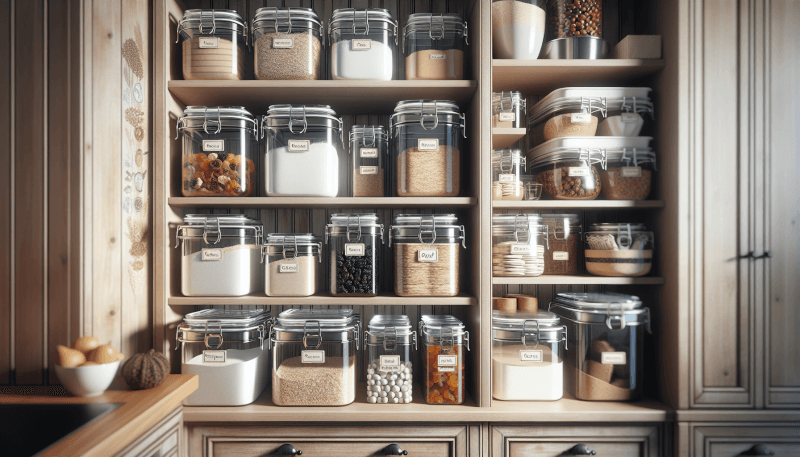If you’re an avid baker or simply like to have a well-stocked pantry, then you know the struggle of keeping your bulk baking ingredients fresh for the long haul. From flour and sugar to baking soda and chocolate chips, it’s essential to store these items properly to maintain their quality and prevent wastage. In this article, discover practical and efficient tips on how to store your bulk baking ingredients for long term use, ensuring that you always have the necessary supplies on hand for your next delicious creation.

Choosing the Right Containers
When it comes to storing your bulk baking ingredients, choosing the right containers is essential. Here are some factors to consider:
Consider container material
The material of the container can greatly impact the longevity of your ingredients. Opt for containers made of food-grade materials such as glass, plastic, or stainless steel. These materials are durable, easy to clean, and safe for storing food.
Opt for airtight containers
To ensure the freshness and prevent the ingredients from going stale, it is crucial to choose containers that are airtight. Airtight containers create a seal that prevents air from entering and causing the ingredients to deteriorate.
Choose containers with secure lids
Containers with secure lids are essential to prevent leaks and spills. They not only help maintain the freshness of your ingredients but also prevent cross-contamination with other foods. Look for containers with tight-fitting lids that securely lock in place.
Select opaque containers
Light can degrade the quality of certain ingredients, especially those that are sensitive to sunlight. Opt for opaque containers that block out light and help preserve the integrity of your ingredients. This is particularly important for items like flour and spices.
Use food-grade containers
When storing edible ingredients, always choose food-grade containers. These containers are specifically designed to be safe for storing food items, ensuring that no harmful chemicals or contaminants leach into your ingredients.
Properly Labeling and Organizing
Once you have chosen the right containers, it is crucial to properly label and organize them to maximize efficiency and minimize waste. Here’s how:
Label containers with contents and date
Labeling containers with the contents and date is essential for efficient organization. It helps you easily identify ingredients and track their freshness. Use waterproof labels or markers to ensure the labels remain intact even in humid environments.
Maintain a detailed inventory
Keeping a detailed inventory of your ingredients is incredibly helpful, especially when you purchase in bulk. Having an organized list of what you have on hand ensures you know what needs to be replenished and prevents unnecessary duplicate purchases.
Organize ingredients by type
Organizing your ingredients by type makes it easier to locate what you need quickly. Group similar items together, such as flours, sugars, leavening agents, fats, nuts, and spices. This way, you have a clear visual of what you have and can easily find what you’re looking for.
Create a rotation system
To prevent ingredients from going unused and eventually expiring, establish a rotation system. By placing newly purchased ingredients at the back and using the older ones first, you ensure that nothing goes to waste. This method is particularly useful for perishable items like leavening agents and nuts.
Keep an eye on expiration dates
While bulk ingredients can last longer than smaller packages, it is essential to keep an eye on expiration dates. Regularly check the freshness of your ingredients and make sure to use them before they expire. Be aware that certain items, such as yeast and ground spices, have shorter shelf lives and should be replaced accordingly.
Ideal Storage Conditions
Creating the ideal storage conditions for your bulk baking ingredients is key to maintaining their quality and extending their shelf life. Follow these guidelines:
Store in a cool and dry place
To maintain the freshness of your ingredients, store them in a cool and dry place. Excessive heat can cause ingredients to spoil, while moisture can lead to clumping and mold growth. Avoid storing them near heat sources like ovens or stoves.
Avoid exposure to sunlight
Sunlight can degrade the quality of certain ingredients, causing them to lose flavor and nutritional value. Keep your containers away from direct sunlight by storing them in a pantry or cupboard.
Prevent contact with moisture
Moisture is the enemy of many baking ingredients, causing them to clump, go stale, or grow mold. Ensure containers are tightly sealed to prevent any moisture from entering. Additionally, avoid storing ingredients near areas with high humidity, such as the dishwasher or sink.
Maintain stable temperature
Fluctuating temperatures can adversely affect the quality of your ingredients. Aim to store them in an area with a consistent temperature, preferably between 50°F and 70°F (10°C and 21°C). Avoid storing them in places prone to temperature changes, such as near air vents or windows.
Keep away from strong odors
Certain ingredients, like spices, can easily absorb strong odors from other foods. To preserve the flavors of your ingredients, store them away from strong-smelling foods, cleaning products, or chemicals. Consider using odor-proof containers if necessary.
Flour Storage
Flour is a staple in baking, and proper storage is crucial to maintain its freshness and prevent spoilage. Follow these guidelines for storing flour:
Choose airtight containers
To keep your flour fresh and free from moisture, opt for airtight containers. Whether it’s a glass jar with a rubber-sealed lid or a plastic container with a secure lock, make sure it has a tight seal.
Place in a cool and dark pantry
Flour is sensitive to heat and light, which can cause it to go rancid and lose its quality. Store your flour in a cool pantry or cupboard, away from direct sunlight and heat sources like the stove.
Consider freezing for long-term storage
If you anticipate not using all of your flour within a few months, consider freezing it for long-term storage. Place the flour in an airtight bag or container and label it with the date. Frozen flour can typically last up to a year without any noticeable changes in quality or taste.
Discard any infested flour
Unfortunately, pests can sometimes find their way into your pantry. If you notice any signs of infestation, such as tiny bugs or larvae, discard the affected flour immediately. It’s essential to regularly inspect your stored flour for any unwanted visitors.
Use within a year
While flour can last for several years, its quality gradually deteriorates over time. To ensure the best baking results, try to use your stored flour within a year. Freshly purchased flour will yield better texture and flavor in your baked goods.

Sugar Storage
Properly storing sugar is essential to prevent clumping, retain flavor, and ensure it stays fresh for extended periods. Follow these guidelines for storing different types of sugar:
Use airtight containers
Sugar easily absorbs moisture from the environment, leading to clumping and a loss of quality. Using airtight containers will help preserve its texture and flavor. Glass or plastic containers with tightly sealed lids work well for storing sugar.
Keep away from humidity
Humidity is the enemy of sugar, as moisture will cause it to clump and harden. Store your sugar in a dry area, away from sources of moisture such as dishwashers or sinks. Avoid storing it near the refrigerator, as condensation can also affect its quality.
Inspect for moisture or clumps
Regularly inspect your stored sugar for any signs of moisture or clumps. If you notice any, gently break up the clumps with a fork or spoon. Consider transferring the sugar to a new container with a fresh seal to prevent further clumping.
Avoid storing near strong odors
Sugar can easily absorb odors from other foods, leading to off-flavors in your baked goods. Keep sugar away from strong-smelling foods, spices, or cleaning products. Storing it in a separate cupboard or pantry shelf can help prevent any unwanted flavors.
Use within two years
Sugar has an almost indefinite shelf life, but its quality can degrade over time. To ensure optimal taste and performance, it is recommended to use your stored sugar within two years. While it may still be safe to use beyond that timeframe, the taste and texture may be compromised.
Leavening Agents Storage
Leavening agents like baking powder and baking soda are essential for achieving the perfect rise in your baked goods. Proper storage is crucial to maintaining their effectiveness. Follow these guidelines for storing leavening agents:
Use airtight containers
Leavening agents are highly susceptible to moisture, which can cause clumping and loss of effectiveness. Store them in airtight containers to prevent any contact with humidity. Consider using smaller jars or containers to minimize air exposure when opening and closing them.
Keep away from moisture
Moisture is the enemy of leavening agents, as it can render them ineffective. Make sure the containers are tightly sealed and stored in a dry area. Avoid storing them near the sink or any other sources of moisture.
Store in a cool and dry place
Leavening agents should be stored in a cool and dry place to maintain their potency. Avoid exposing them to heat sources or extreme temperature fluctuations. Keeping them in a pantry or cupboard away from the oven or stove is ideal.
Check for expiration dates
Leavening agents have a finite shelf life, and their effectiveness diminishes over time. Check the expiration dates on your containers and discard any that have expired. Using expired leavening agents may result in flat or dense baked goods.
Replace every 6-12 months
To ensure optimal performance, it is recommended to replace your leavening agents every 6-12 months, even if they haven’t expired. Over time, they can lose their potency, leading to less reliable results in your baking. Fresh leavening agents will give your baked goods the perfect rise.

Fats Storage
Fats, such as oils and solid shortenings, are commonly used in baking to add moisture and flavor. Proper storage is essential to prevent rancidity and maintain their quality. Follow these guidelines for storing fats:
Choose opaque airtight containers
Fats are sensitive to light and air, which can lead to oxidation and rancidity. Opt for opaque containers that block out light, such as metal tins or dark-colored plastic containers. Ensure the containers have airtight seals to prevent any exposure to air.
Store in a cool and dark pantry
Fats should be stored in a cool and dark environment to prolong their freshness. Avoid placing them near heat sources or areas prone to temperature fluctuations. Keeping them in a pantry or cupboard away from direct sunlight is best.
Prevent contact with air and light
Air and light can accelerate the oxidation process of fats, causing them to become rancid. Ensure that your containers are tightly sealed and stored in a dark area. If possible, choose smaller containers to minimize the amount of air present when opened.
Check for rancidity regularly
Fats can turn rancid over time, resulting in an off-putting smell and taste. Regularly check your stored fats for any signs of rancidity, such as a strong, unpleasant odor or a bitter flavor. If you detect any rancidity, it’s best to discard the fat and replace it with fresh ones.
Use within 6-12 months
To ensure the best taste and quality in your baked goods, try to use your stored fats within 6-12 months. While they may still be safe to consume beyond that timeframe, their flavor and performance may be compromised.
Nuts and Seeds Storage
Nuts and seeds are nutrient-rich ingredients often used in baking to add flavor and texture. Proper storage is crucial to prevent rancidity and preserve their taste. Follow these guidelines for storing nuts and seeds:
Select airtight and moisture-proof containers
Nuts and seeds are prone to absorbing moisture, which can lead to spoilage and loss of crunchiness. Choose airtight and moisture-proof containers to ensure they stay fresh. Mason jars or resealable plastic bags work well for this purpose.
Keep in a cool and dark place
Nuts and seeds should be stored in a cool and dark area to prevent rancidity. Excessive heat can accelerate their degradation and diminish their flavor. Store them in a pantry or cupboard away from direct sunlight or heat sources.
Avoid storing near heat sources
Heat can accelerate the process of nuts and seeds going rancid. Avoid storing them near heat sources like the oven or stovetop, as well as areas prone to temperature fluctuations. Keeping them in a cool spot with consistent temperatures helps maintain their quality.
Check for rancidity and insect damage
Regularly inspect your nuts and seeds for signs of rancidity or insect damage. Rancid nuts will have an off smell and taste, while insect-damaged ones may have small holes or visible pests. Discard any nuts or seeds that show signs of spoilage or infestation.
Use within 6-12 months (or as specified)
While nuts and seeds can stay edible for extended periods, their flavor and texture gradually deteriorate over time. It is best to consume them within 6-12 months, or as specified for specific varieties. Using fresh nuts and seeds will ensure optimal flavor and crunchiness in your baked goods.

Spices and Extracts Storage
Spices and extracts are essential for adding depth and flavor to your baked goods. Proper storage is crucial to preserve their potency and prevent flavor deterioration. Follow these guidelines for storing spices and extracts:
Use airtight containers
To prevent moisture, air, and light from degrading your spices and extracts, store them in airtight containers. Glass jars with tight-fitting lids or small resealable bags work well for this purpose. Ensure that the containers are clean and dry before filling them with spices.
Store away from heat and light
Heat and light can cause spices and extracts to lose their potency and flavor. Keep your containers in a cool and dark place, such as a pantry or cupboard. Avoid storing them near the oven or stovetop, as the heat can degrade their quality.
Avoid moisture exposure
Spices and extracts are sensitive to moisture, as it can cause clumping and accelerate flavor deterioration. Keep your containers tightly sealed and store them away from areas with high humidity, such as the sink or dishwasher. Avoid using wet measuring spoons or hands when scooping spices to prevent introducing moisture.
Check for flavor potency
Over time, spices may lose their potency and become less flavorful. To ensure optimal taste in your baked goods, periodically check the flavor of your stored spices and extracts. If they have significantly diminished in taste, it may be time to replace them with fresh ones.
Replace ground spices every 1-3 years
Ground spices have a shorter shelf life than whole spices due to their increased surface area. While they may still be safe to use beyond this timeframe, their flavor and potency will gradually diminish. Replace ground spices every 1-3 years to ensure the best flavor in your baking.
Yeast Storage
Yeast is a crucial ingredient for leavening bread and other baked goods. Proper storage is essential to maintain its effectiveness and ensure successful fermentation. Follow these guidelines for storing yeast:
Use airtight containers or vacuum seal
To prevent exposure to air and moisture, store yeast in airtight containers or use a vacuum sealer. Oxygen and moisture can weaken the yeast cells, leading to reduced fermentation and poor rise in your baked goods.
Store in a cool and dry place
Yeast is sensitive to temperature and humidity changes, which can compromise its viability. Store it in a cool and dry place, such as a refrigerator or freezer. Avoid exposing it to excessive heat or extreme temperature fluctuations.
Avoid temperature fluctuations
Yeast prefers a stable temperature environment for optimal fermentation. Exposing it to temperature fluctuations can reduce its effectiveness. Keep yeast away from heat sources and avoid placing it near the door of the refrigerator, where temperatures can fluctuate.
Check yeast viability regularly
To ensure the yeast is still active and viable, perform a simple test before using it in your baking. Dissolve a small amount of yeast in warm water with a pinch of sugar and wait for it to foam. If the yeast doesn’t produce any bubbles or foam, it may have lost its viability and should be replaced.
Replace every 6-12 months
While yeast can still be used beyond its expiration date, its effectiveness gradually diminishes over time. To ensure the best rise in your baked goods, it is recommended to replace yeast every 6-12 months, even if it hasn’t expired. Fresh yeast will provide better fermentation and a lighter texture.
By following these guidelines for choosing the right containers, properly labeling and organizing, and providing ideal storage conditions for your bulk baking ingredients, you can ensure their freshness, quality, and longevity for long-term use. With a well-organized pantry and properly stored ingredients, you’ll be ready to whip up delicious baked treats whenever the cravings strike. Happy baking!



